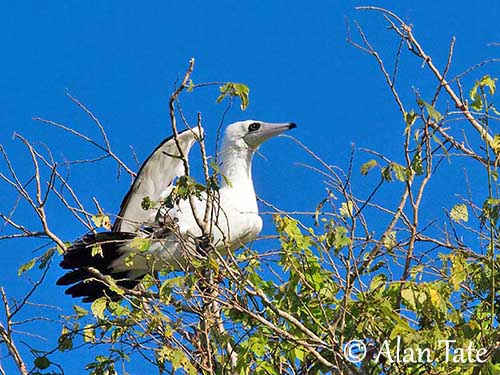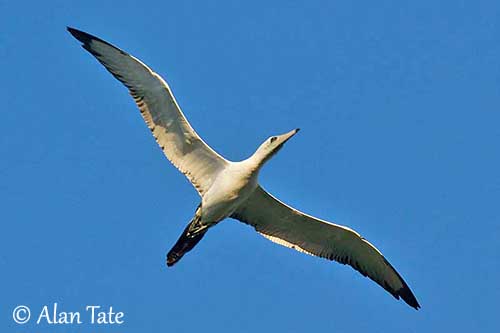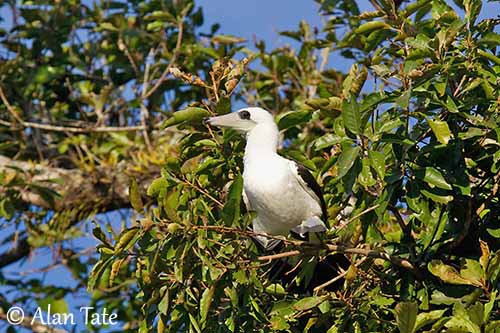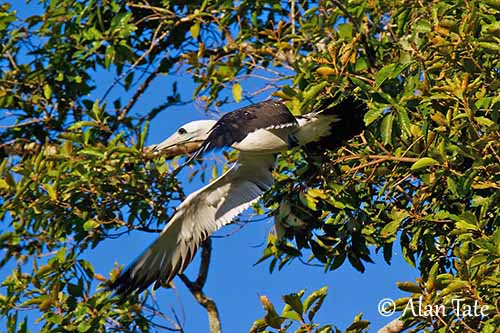
Fr: Fou d’Abbott
Ang: Abbott’s booby
All: Abbott-Tölpel
Esp: Piquero de Abbott
Ita: Sula di Abbott
Nd: Abbotts Gent
Sd: Christmassula
Photographers:
Alan & Ann Tate
AA Bird Photography
Text by Nicole Bouglouan
Sources :
HANDBOOK OF THE BIRDS OF THE WORLD vol 1 by Josep del Hoyo-Andrew Elliot-Jordi Sargatal - Lynx Edicions - ISBN: 8487334105
BirdLife International (BirdLife International)
Wikipedia, the free encyclopaedia
Australian Government – Department of the Environment
Christmas Island – Seabird Project
Christmas Island – Island Life
Marine Ornithology – Journal of Seabird Science and Conservation
Abbott’s Booby
Papasula abbotti
Suliformes Order – Sulidae family
INTRODUCTION:
The Abbott’s Booby is placed within its own monotypic genus Papasula. Its name pays tribute to William Louis Abbott who discovered this bird in 1892 on Assumption Island.
The Abbott’s Booby has extremely restricted range on Christmas Island in the E Indian Ocean, and the population is decreasing due to habitat destruction. But the major threat is the introduction of Anoplolepis gracilipes or Yellow crazy ant, which has a significant destructive impact on the ecosystem.
Control measures in 2009 allowed reducing the populations of this ant, but the Abbott’s Booby is currently listed as Endangered.


DESCRIPTION OF THE BIRD:
Biometrics:
Length: 79-80 cm
Weight: 1400-1600 g
The adult has white head and neck, with elongated feathers on the nape giving a shaggy appearance. Rest of upperparts is white with black blotches or spots on rump and uppertail-coverts. Scapulars and upperwing are mostly black with some white markings at base of the wings and carpal joint. The tail is black.
The underparts are white, but on the underwing, the primaries show broad black tips, smaller on secondaries and tertials. We can see an irregular black patch from rear thighs through rear flanks.
In worn plumage, the black areas become dull brown, while the white areas show some dull orange staining.
The head is white. The bill is pale bluish-grey and can be sometimes slightly washed pink. The base is bluer, there is a blackish line between the upper base and the forehead, and the tip is black. The bill is coarsely serrated along the cutting edges of both mandibles.
The eyes are dark brown, surrounded by blackish facial skin on lores and eye’s area. The anterior eyelids are mostly pale greyish.
Legs and webbed feet are bluish-grey with blackish areas on the webs. The claws are horn-coloured.
Both sexes are similar, although the female has pink bill, becoming duller during the breeding season.
The juvenile resembles adult male but its eyes are paler.
RANGE:
The Abbott’s Booby breeds on the small Christmas Island in E Indian Ocean. This species forages and disperses over long distances. Its range was probably much wider in the past, through Indian and Pacific Oceans.

HABITAT:
The Abbott’s Booby breeds in rainforest in tall trees on the plateau and in the upper terrace forest of Christmas Island, between 160 and 260 metres of elevation. This species forages in the Indian Ocean, in a nutrient-rich area off the coast of Java.
CALLS AND SONGS: SOUNDS BY XENO-CANTO
The Abbott’s Booby is very vocal. It has a wide repertoire of croaks, guttural grunts and groans. At the nest-site, it utters loud “aaw-ah-err” and “ku-ark ko-ark”.
BEHAVIOUR IN THE WILD:
The Abbott’s Booby feeds on fish and squid, found in the cold water upwelling close to Christmas Island. The fishing trips are usually long and the bird may travel up to 400 kilometres to its feeding areas when breeding on Christmas Island.
Like other Sulidae species, it feeds by plunge-diving into the ocean.
The Abbott’s Booby is solitary nester. When they return to their breeding areas after the post-breeding dispersal, they use ritual and elaborate courtship displays, in order to re-establish the pair bonds. Then, they build the nest in tall trees, between 20 and 40 metres above the ground.
The Abbott’s Booby is able to travel long-distances, up to thousands of kilometres from Christmas Island. This large seabird is well-adapted to long-distance flight. Due to the long, narrow wings, it needs a clear space to land and to take off. As it nests in tall trees, it can get enough lift from the wind.
REPRODUCTION OF THIS SPECIES:
The breeding season takes place between April and July, with mating in April and most laying in May-July.
They nest solitary with about 9 pairs/ha. The nest is built in the canopy of tall tree, close to gullies, hills or cliffs for easier take-off and landing.
The Abbott’s Booby has long breeding cycle of 15-18 months and the pairs only breed once every two years. Both sexes build a stick platform at treetop.
The female lays a single egg. The incubation is shared by both adults during 56-57 days during which they take turns of up to two days each. At hatching, the chick is covered with whitish down. It is fed by both parents by regurgitation.
The chick needs 170 days to acquire the full plumage, and it is finally independent about 200 days after hatching. It reaches the sexual maturity at 8 years of age.
PROTECTION / THREATS / STATUS:
The Abbott’s Booby is mainly threatened by the introduced Yellow crazy ant which forms huge colonies and preys on insects, earthworms, crabs (very numerous on the islands), mammals, birds and reptiles, and has a significant destructive impact on the ecosystem and especially on the forest.
Invasive plant species start to affect the habitat of the Abbott’s Booby. In addition, the strong winds in this area can impact the breeding success of these birds by destroying the nests. Marine pollution and over-fishing are other important threats at sea.
The population was evaluated in 1991 at 6,000 mature birds, equating to 9,000 individuals in total.
All these threats and the restricted breeding range have led to decline of the population, and currently, the Abbott’s Booby is listed as Endangered.
